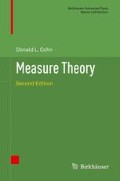Abstract
Chapter 2 is devoted to the definition and basic properties of the Lebesgue integral. functions, the functions that are simple enough that the integral can be defined for them, if their values are not too large (Section 2.1). After a brief look in Section 2.2 at properties that hold almost everywhere (that is, that may fail on some set of measure zero, as long as they hold everywhere else), we turn to the definition of the Lebesgue integral and to its basic properties (Sections 2.3 and 2.4). The chapter ends with a sketch of how the Lebesgue integral relates to the Riemann integral (Section 2.5) and then with a few more details about measurable functions (Section 2.6).
Access this chapter
Tax calculation will be finalised at checkout
Purchases are for personal use only
Notes
- 1.
Recall that \(0 \cdot (+\infty ) = 0\) and that if x≠ −∞, then \(x + (+\infty ) = (+\infty ) + x = +\infty \). See Appendix B.
- 2.
An extended real-valued function is, of course, a \([-\infty, +\infty ]\)-valued function.
- 3.
There are also cases of functions defined on \(\mathbb{R}\) that are not Lebesgue integrable over \(\mathbb{R}\) but for which the corresponding improper integral exists. For instance, define \(f : \mathbb{R} \rightarrow \mathbb{R}\) by f(x) = 0 if x < 1 and \(f(x) = {(-1)}^{n}/n\) if n ≤ x < n + 1, where n = 1, 2, ….
- 4.
Another notation for μf − 1 is μ ∘ f − 1.
References
Daniell, P.J.: A general form of integral. Ann. of Math. (2) 19, 279–294 (1917–1918)
Halmos, P.R.: Measure Theory. Van Nostrand, Princeton (1950). Reprinted by Springer, 1974
Stone, M.H.: Notes on integration. Proc. Nat. Acad. Sci. U.S.A. 34, 336–342, 447–455, 483–490 (1948); Stone, M.H.: Notes on integration. Proc. Nat. Acad. Sci. U.S.A. 35, 50–58 (1949)
Author information
Authors and Affiliations
Rights and permissions
Copyright information
© 2013 Springer Science+Business Media New York
About this chapter
Cite this chapter
Cohn, D.L. (2013). Functions and Integrals. In: Measure Theory. Birkhäuser Advanced Texts Basler Lehrbücher. Birkhäuser, New York, NY. https://doi.org/10.1007/978-1-4614-6956-8_2
Download citation
DOI: https://doi.org/10.1007/978-1-4614-6956-8_2
Published:
Publisher Name: Birkhäuser, New York, NY
Print ISBN: 978-1-4614-6955-1
Online ISBN: 978-1-4614-6956-8
eBook Packages: Mathematics and StatisticsMathematics and Statistics (R0)

